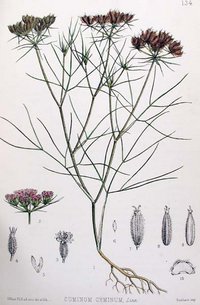| Cumin | ||||||||||||||
|---|---|---|---|---|---|---|---|---|---|---|---|---|---|---|
| Scientific classification | ||||||||||||||
|
Cumin (Cuminum cyminum) is a plant and a spice with a distinctive aroma, popular in Mexican, North African, and Indian cuisine. It belongs to the family Apiaceae, which is popularly called the carrot family.
History
Cumin has been grown and used as a spice since ancient times. Originally cultivated in Iran and the Mediterranean region, cumin was known in ancient Greece and Rome. The Greeks kept cumin at the dining table in its own container, much as pepper is frequently kept today. Cumin fell out of favor in Europe (except in Spain) during the Middle Ages, but is widely used today. It is now mostly grown in Morocco, Egypt, India, Syria, North America, and Chile.
The name
The name cumin is a distortion of the Persian city Kerman, where most of ancient Persia's cumin was produced. For the Persians the expression carrying "cumin to Kerman" means: "to carry coal to Newcastle". Kerman, locally called Kermun, became Kumun and then cumin in the European languages.
In India, cumin is known as jeera.
Description of plant
The cumin plant is an annual herb. Its stem is slender and branching to about a foot in height; the leaves are laciniate with filiform segments; the flowers are small, white or pink, and borne in umbels. The so-called seeds are its fruits, which are achenes. These, which constitute the spice cumin, are fusiform or ovoid in shape, and compressed laterally. Cumin seeds looks similar to fennel seeds, but are smaller and darker in color.
The spice cumin
Cumin fruits have a distinctive bitter flavor and strong, warm aroma due to their abundant essential oil content. Its main constituent and important aroma compound is cuminaldehyde (4-isopropylbenzaldehyde). Important aroma compounds of toasted cumin are the substituted pyrazines, 2-ethoxy-3-isopropylpyrazine, 2-methoxy-3-sec-butylpyrazine, and 2-methoxy-3-methylpyrazine. Their smell can also be detected in the eater's sweat even after consuming only small amounts.
Today, cumin is identified with Indian cuisine and Mexican cuisine. It is used as an ingredient of curry powder. Cumin can be found in some Dutch cheeses, and in some traditional breads from France. In herbal medicine, cumin is classified as stimulant, carminative, and antimicrobial.
Confusion with other spices
Cumin is hotter to the taste, lighter in colour, and larger than caraway (Carum carvi), another umbelliferous spice that is sometimes confused with it. Cumin is also not related to black cumin, which is an alternate name for nigella (Nigella sativa).

